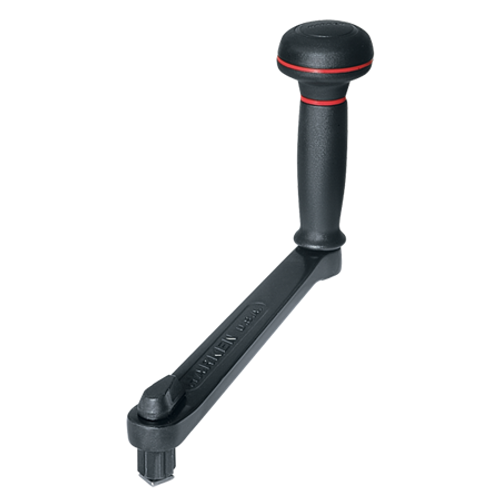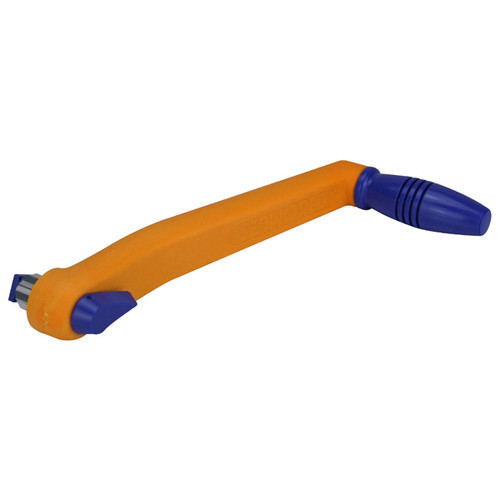-

Harken
Harken Aluminum SpeedGrip Lock-In Winch Handle - 254mm
SpeedGrip handles are designed for the serious racer and effective in both light and heavy air conditions. The unique grip permits low-load fast cranking using the palm, and powerful two-handed grinding when loads are high. A (mm) 254mm B...
-

Harken
Harken Aluminum Low-Profile SpeedGrip Lock-In Winch Handle - 203mm
SpeedGrip handles are designed for the serious racer and effective in both light and heavy air conditions. The unique grip permits low-load fast cranking using the palm, and powerful two-handed grinding when loads are high. The low-profile B8ASGLP is...
-

Harken
Harken Aluminum Double-Grip Lock-In Winch Handle - 254mm
These robust low-friction ball bearing handles match a wide range of cranking needs for both racers and cruisers. Handles feature a ball bearing grip that efficiently transmits power into the winch. The B10ADL handle features a lock-in switch and...
-

Harken
Harken Chrome Lock-In Winch Handle - 203mm
These robust low-friction ball bearing handles match a wide range of cranking needs for both racers and cruisers. Handles feature a ball bearing grip that efficiently transmits power into the winch. Lock-in handles are easy to engage and release with a...
-

Harken
Harken Chrome Lock-In Winch Handle - 254mm
These robust low-friction ball bearing handles match a wide range of cranking needs for both racers and cruisers. Handles feature a ball bearing grip that efficiently transmits power into the winch. Lock-in handles are easy to engage and release with a...
-

Harken
Harken Bronze Lock-In Winch Handle - 203mm
These robust low-friction ball bearing handles match a wide range of cranking needs for both racers and cruisers. Handles feature a ball bearing grip that efficiently transmits power into the winch. Lock-in handles are easy to engage and release with a...
-

Harken
Harken Bronze Lock-In Winch Handle - 254mm
These robust low-friction ball bearing handles match a wide range of cranking needs for both racers and cruisers. Handles feature a ball bearing grip that efficiently transmits power into the winch. Lock-in handles are easy to engage and release with a...
-

Harken
Harken Aluminum Winch Handle - Lock-In
These robust low-friction ball bearing handles match a wide range of cranking needs for both racers and cruisers. Handles feature a ball bearing grip that efficiently transmits power into the winch. Lock-in handles are easy to engage and release with a...
-

PVC Pocket Winch Handle
Made from heavy-duty white flexible PVC. Suits upto a 290mm winch handles. Includes 4 x stainless steel fastenings. Part numberDescriptionLengthWidthSAW-70715PVC Pocket Winch Handle300mm90mm
-

Nylon Winch Handle Holder
Designed to fit with any of the Lock-in winch handle. Heavy-duty nylon. Plastic gasket. Surface mounting. 3 x 5mm mounting holes. Part numberDescriptionDiameterN/A SAW-70716 Nylon Winch Handle Holder Surface 52mm -
-

Floating 10" Winch Handle
Anyone who has lost a winch handle overboard will appreciate these floating winch handles. Made from glass fibre-reinforced plastic providing a strong light-weight winch handle. Ball bearings in the handle provide a fast and smooth cranking action...
-

316 Stainless Locking Winch Handle
Stainless steel polished finish. Thick frame for strength. Nylon handle. 2 way lock and unlock release. Suits all common sheet winches Part numberDescriptionLengthN/A SAW-70710 Lock-In Stainless Steel Winch Handle 290mm 290mm -
Winches & Accessories
A sailboat winch is a mechanical device that is used to pull in (wind up) or let out (wind out) or otherwise adjust the tension of a rope or wire rope (also called "cable" or "wire cable"). They are used on sailboats to control the sails and rigging.
Winches come in a variety of sizes and types, but they all have the same basic components:
- A drum: This is the spool that the rope or wire rope is wound around.
- A pawl: This is a small, tooth-like device that engages with the teeth on the drum to prevent the rope or wire rope from unwinding.
- A ratchet: This is a mechanism that allows the winch to be turned in one direction only.
- A handle: This is used to turn the winch.
There are four main types of sailboat winches:
- Snubbing winches: These are simple winches that do not have a self-tailing mechanism. They are used to control lines that do not need to be adjusted frequently, such as the anchor line.
- Plain-top winches: These winches have a self-tailing mechanism, but they do not have a ratchet. They are used for lines that need to be adjusted frequently, such as the jib sheets.
- Self-tailing winches: These winches have a self-tailing mechanism and a ratchet. They are the most common type of winch on sailboats.
- Electric winches: These winches are powered by an electric motor. They are used on large sailboats and racing sailboats.
Winches are an essential part of sailing. They allow sailors to control the sails and rigging with ease, even when the wind is strong.
Here are some additional details about the different types of sailboat winches:
- Snubbing winches: Snubbing winches are the simplest type of winch. They do not have a self-tailing mechanism, so the sailor must manually tail the line after each turn of the winch. This can be time-consuming and difficult, especially when the wind is strong.
- Plain-top winches: Plain-top winches have a self-tailing mechanism, which means that the line automatically tails itself after each turn of the winch. This makes them much easier to use than snubbing winches, and they are the most common type of winch on sailboats.
- Self-tailing winches: Self-tailing winches have a self-tailing mechanism and a ratchet. This makes them the most versatile type of winch, as they can be used for both light and heavy lines.
- Electric winches: Electric winches are powered by an electric motor, which allows them to be used to control even the heaviest lines. They are used on large sailboats and racing sailboats.
When choosing a winch for your sailboat, it is important to consider the size of your boat, the type of sailing you do, and your budget. Snubbing winches are a good option for small boats and dinghies, while plain-top winches are a good option for larger boats that are used for cruising. Self-tailing winches are a good option for all types of boats, and electric winches are a good option for large boats and racing sailboats.




















